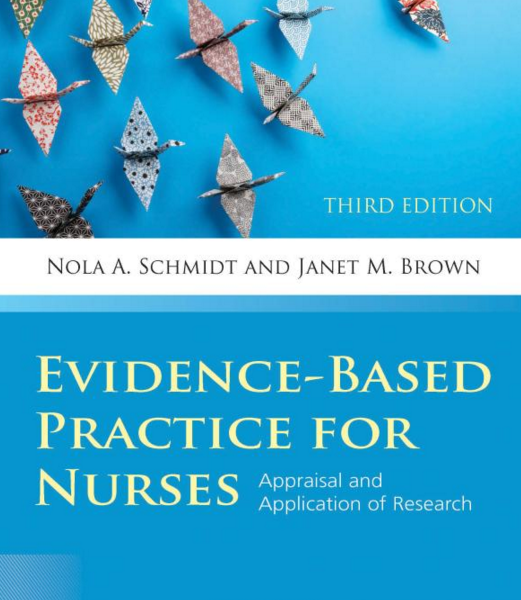Test Bank Evidence Based Practice Nurses Appraisal 3rd Edition Schmidt Brown
$35.00 Original price was: $35.00.$26.50Current price is: $26.50.
Test Bank Evidence Based Practice Nurses Appraisal 3rd Edition Schmidt Brown
This is completed downloadable of Test Bank Evidence Based Practice Nurses Appraisal 3rd Edition Schmidt Brown digital download immediately after payment is complete.

Product Details:
- ISBN-10 : 128405330X
- ISBN-13 : 978-1284053302
- Author: Nola A. Schmidt, Janet M. Brown
Each new print copy includes Navigate 2 Advantage Access that unlocks a complete eBook, Study Center, homework and Assessment Center, and a dashboard that reports actionable data. Evidence-Based Practice for Nurses: Appraisal and Application of Research, Third Edition is the definitive reference for transitioning research into nursing practice. Based on the innovation-decision process (IDP), each unit is shaped according to the five steps of the IDP: knowledge, persuasion, decision, implementation, and confirmation. This unique organizational approach, combined with updated case studies and ethical principles, allows the research process to be tangible and linked with strategies that promote advancement. KEY FEATURES: Updated and expanded “Apply What You Have Learned” feature prompts students to find, read, and evaluate current research “Keeping it Ethical” ties relevant ethical issues in to each chapter Practice questions in every chapter help students test their knowledge as they work through the material Chapter objectives, key terms, and critical thinking exercises help guide and focus study Instructor Resources: Instructor’s Manual Lecture outlines in PowerPoint format Test bank
Table of Content:
- Unit 1 Introduction to Evidence-Based Practice
- Chapter 1 What Is Evidence-Based Practice?
- 1.1 EBP: What Is It?
- 1.2 What Is Nursing Research?
- 1.3 How Has Nursing Evolved as a Science?
- 1.4 What Lies Ahead?
- 1.5 Keeping It Ethical
- Chapter 2 Using Evidence Through Collaboration to Promote Excellence in Nursing Practice
- 2.1 The Five Levels of Collaboration
- 2.2 Keeping It Ethical
- Unit 2 Acquisition of Knowledge
- Chapter 3 Identifying Research Questions
- 3.1 How Clinical Problems Guide Research Questions
- 3.2 Developing Hypotheses
- 3.3 Formulating EBP Questions
- 3.4 Keeping It Ethical
- Chapter 4 Finding Sources of Evidence
- 4.1 Purpose of Finding Evidence
- 4.2 Types of Evidence
- 4.3 How Sources Are Organized
- 4.4 How to Search for Evidence
- 4.5 Keeping It Ethical
- Chapter 5 Linking Theory, Research, and Practice
- 5.1 How Are Theory, Research, and Practice Related?
- 5.2 Keeping It Ethical
- Unit 3 Persuasion
- Chapter 6 Key Principles of Quantitative Designs
- 6.1 Chart the Course: Selecting the Best Design
- 6.2 What Is Validity?
- 6.3 Categorizing Designs According to Time
- 6.4 Keeping It Ethical
- Chapter 7 Quantitative Designs: Using Numbers to Provide Evidence
- 7.1 Experimental Designs
- 7.2 Quasi-Experimental Designs
- 7.3 Nonexperimental Designs
- 7.4 Specific Uses for Quantitative Designs
- 7.5 Keeping It Ethical
- Chapter 8 Epidemiologic Designs: Using Data to Understand Populations
- 8.1 Epidemiology and Nursing
- 8.2 Infectious Diseases and Outbreak Investigations
- 8.3 Measures of Disease Frequency
- 8.4 Descriptive Epidemiology
- 8.5 Descriptive Study Designs
- 8.6 Analytic Study Designs
- 8.7 Screening
- 8.8 Evaluating Health Outcomes and Services
- 8.9 Keeping It Ethical
- Chapter 9 Qualitative Designs: Using Words to Provide Evidence
- 9.1 What Is Qualitative Research?
- 9.2 The Four Major Types of Qualitative Research
- 9.3 Keeping It Ethical
- Chapter 10 Collecting Evidence
- 10.1 Data Collection: Planning and Piloting
- 10.2 Collecting Quantitative Data
- 10.3 Validity and Reliability
- 10.4 Collecting Qualitative Data
- 10.5 Keeping It Ethical
- Chapter 11 Using Samples to Provide Evidence
- 11.1 Fundamentals of Sampling
- 11.2 Sampling Methods
- 11.3 Sample Size: Does It Matter?
- 11.4 Keeping It Ethical
- Chapter 12 Other Sources of Evidence
- 12.1 The Pyramid of Evidence: The 5 Ss
- 12.2 Using the Pyramid for Evidence-Based Practice
- 12.3 Keeping It Ethical
- Unit 4 Decision
- Chapter 13 What Do the Quantitative Data Mean?
- 13.1 Using Statistics to Describe the Sample
- 13.2 Using Frequencies to Describe Samples
- 13.3 Measures of Central Tendency
- 13.4 Distribution Patterns
- 13.5 Measures of Variability
- 13.6 Inferential Statistics: Can the Findings Be Applied to the Population?
- 13.7 Reducing Error When Deciding About Hypotheses
- 13.8 Using Statistical Tests to Make Inferences About Populations
- 13.9 What Does All This Mean for EBP?
- 13.10 Keeping It Ethical
- Chapter 14 What Do the Qualitative Data Mean?
- 14.1 Qualitative Data Analysis
- 14.2 Qualitative Data Interpretation
- 14.3 Qualitative Data Evaluation
- 14.4 Keeping It Ethical
- Chapter 15 Weighing In on the Evidence
- 15.1 Deciding What to Do
- 15.2 Appraising the Evidence
- 15.3 Clinical Practice Guidelines: Moving Ratings and Recommendations into Practice
- 15.4 Keeping It Ethical
- Unit 5 Implementation
- Chapter 16 Transitioning Evidence to Practice
- 16.1 Evidence-Based Practice Models to Overcome Barriers
- 16.2 Creating Change
- 16.3 Keeping It Ethical
- Chapter 17 Developing Oneself as an Innovator
- 17.1 Who Is an Innovator?
- 17.2 Developing Oneself
- 17.3 Professionalism
- 17.4 Keeping It Ethical
- Unit 6 Confirmation
- Chapter 18 Evaluating Outcomes of Innovations
- 18.1 What Is an Outcome?
- 18.2 Choosing Outcomes
- 18.3 Evaluating the Outcomes
- 18.4 Keeping It Ethical
- Chapter 19 Sharing the Insights with Others
- 19.1 Dissemination: What Is My Role?
- 19.2 The 3 Ps of Dissemination
- 19.3 Using Technology to Disseminate Knowledge
- 19.4 Making the Most of Conferences
- 19.5 Keeping It Ethical
- Glossary
- Index
People Also Search:
evidence based practice nursing google scholar
evidence based practice for nursing students
evidence-based practice for nurses
Related products
Test Bank
Test Bank for Clinical Immunology and Serology A Laboratory Perspective, 3rd Edition: Stevens
Test Bank
Test Bank for Decision Support and Business Intelligence Systems, 9th Edition: Efraim Turban
Test Bank
Test Bank for Operating Systems: Internals and Design Principles, 7th Edition: William Stallings











